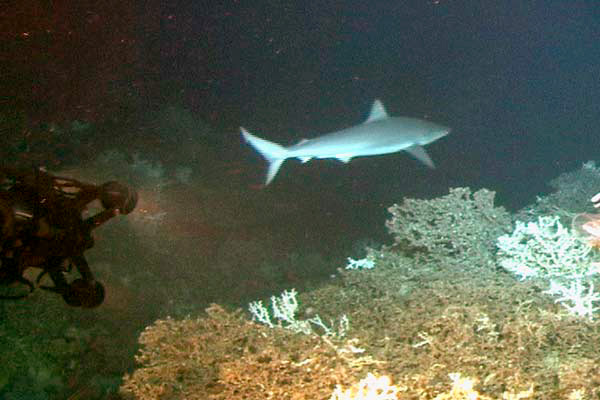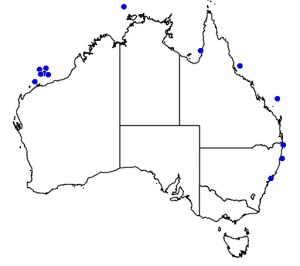Distinguishing features
Rather heavily built, the bignose shark has a long, broad, and blunt snout with the nostrils preceded by well-developed, triangular flaps of skin. The moderately large, circular eyes are equipped with nictitating membranes.
The mouth is broadly curved and lacks obvious furrows at the corners. The upper teeth number 14–16 rows on either side and have tall, broad, triangular cusps with serrated edges; they are erect at the jaw center and become increasingly oblique towards the sides. The lower teeth number 14–15 rows on either side and have narrow, erect cusps with extremely fine serrations. The five pairs of gill slits are moderately long.
The long and wide pectoral fins have pointed tips and nearly straight margins. The first dorsal fin originates roughly over the rear of the pectoral fin bases; it is fairly tall and falcate (sickle-shaped), with a blunt apex and a long free rear tip. The second dorsal fin is relatively large with a short free rear tip, and is positioned slightly ahead of the anal fin. A high midline ridge is present between the dorsal fins. The caudal peduncle has a crescent-shaped notch at the origin of the upper caudal fin margin. The caudal fin has a large lower lobe and a strong ventral notch near the tip of the upper lobe. The dermal denticles are closely spaced but non-overlapping, such as that the skin shows between them; each is oval with three horizontal ridges leading to marginal teeth.
The coloration is gray to bronze above, with a faint pale stripe on the flank, and white below; sometimes there is a green sheen along the gills. The tips of the fins (except for the pelvic fins) are darker; this is most obvious in young sharks. (Wikipedia)
Size
- Up to 300 cm (Total length)
Weight
- Up to 168 kg
Depth range
- Depth range data is not yet available.
Synonyms
Distribution
Distribution and habitat preferences
Patchy records from around the world indicate the bignose shark probably has a circumglobal distribution in tropical and subtropical waters. In the Atlantic Ocean, it occurs from Delaware Bay to Brazil, in the Mediterranean Sea, and off West Africa. In the Indian Ocean, it is known in South Africa and Madagascar, the Red Sea, India, and the Maldives. In the Pacific Ocean, it has been recorded from China to Australia, around Hawaii, and from the Gulf of California to Ecuador. It is reportedly common off Florida, the Bahamas, and the West Indies, and rare off Brazil and in the Mediterranean.
It is found near the edge of the continental shelf and over the upper continental slope, generally swimming close to the sea floor at depths of below 100m.
Young sharks may venture into water as shallow as 25 m.
Night-time captures of this species from close to the surface suggest it may perform a diel vertical migration, moving from deep water upwards or toward the coast at night. In the northwestern Atlantic, the bignose shark conducts a poorly documented seasonal migration, spending summer off the US East Coast and winter in the Gulf of Mexico and the Caribbean Sea. (Wikipedia)

